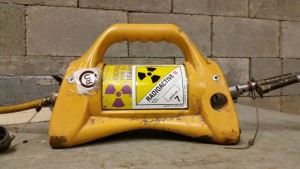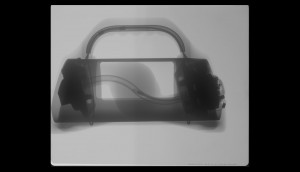Computed Radiography
In the inspection industry, ensuring the reliability of equipment and preventing failures through NDE inspections is of the utmost importance to the customer and the inspector. Failures can lead to pre-mature shut-downs, environmental and safety considerations to say the least. The ability to detect defects accurately, timely and safely is a necessity in today’s industries. The nuclear, chemical, petroleum, and fabrication industries, just to name a few, find this essential. The inability to detect defects can lead to failures that result in lost revenue and even lost lives. With this in mind, any quality NDE inspection service should continuously strive to achieve excellence in quality assurance by exploring cutting edge, highly specialized technologies which will enable detection of defects. Computed Radiography, (CR), is one of the methods that is changing the face of detection and documentation in the industry.
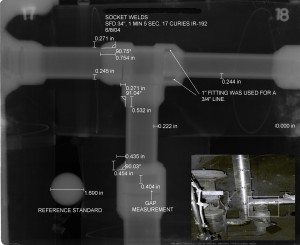 For 70 years, photographic film has been used to record x-ray images. The NDT industry has used this technology to determine fractures, corrosion and other signs of failure. Exposed film is chemically treated and processed to expose the image, which is then displayed on a light box. It is a simple method with good results, aside from the photochemical refuse left behind. It is easily transported, but the authenticity can be compromised by any number of sources. The time it takes for developing, the way it is processed and the damage time alone can do to the image are all factors associated with film. Storage and retrieval of film has also created a problem in terms of space and dollars spent by ever increasing numbers of archived material required by the industry.
For 70 years, photographic film has been used to record x-ray images. The NDT industry has used this technology to determine fractures, corrosion and other signs of failure. Exposed film is chemically treated and processed to expose the image, which is then displayed on a light box. It is a simple method with good results, aside from the photochemical refuse left behind. It is easily transported, but the authenticity can be compromised by any number of sources. The time it takes for developing, the way it is processed and the damage time alone can do to the image are all factors associated with film. Storage and retrieval of film has also created a problem in terms of space and dollars spent by ever increasing numbers of archived material required by the industry.
Surprisingly, CR has been available for decades. Until recently, through technological advancements with computers, phosphor technology and high resolution monitors, computed radiography has become more attractive in terms of quality, mobility and cost effectiveness.
Computed Radiography has become an economically feasible application for the NDT industry by eliminating the protocol associated with the chemical processing, minimizing retakes, and lowering distribution costs of transmission of data. CR also allows for a quicker review process for the technician and immediate quality assurance for the customer. The images sent and/or archived are identical to the original.
CR combines conventional radiography with digitized computer imaging. The radiographic technique remains the same, and the advantages are overwhelming. The era of evacuating whole structures, floors and entire operating areas of personnel in order to perform radiography is practically eliminated. In place of the traditional x-ray emulsion film is the use of phosphor imaging plates. These plates allow images to be captured more readily with the use of Iridium-192, Selinium-75, Cobalt, X-Ray, etc… The radioactive source strength required has decreased significantly. For Ir-192, using 3 – 9 curies is sufficient. This allows for smaller barriers, virtually eliminating the need to evacuate areas. In addition, exposure times have decreased approximately 75% which has increased productivity, yielding higher results. Exposures can be taken safely within 10-15 feet of personnel without interruption. The phosphor imaging plates can be re-used thousands of times, eliminating film costs. Because chemicals are no longer required to develop the images, there is no time lost in developing and drying and you do not generate any hazardous waste. The imaging plates are sent through an electronic scanner that places the image on your computer screen in less than 90 seconds.
The image can then be reduced, magnified, rotated, inverted or switched between a positive and negative image for optimum viewing. The unique software package has the ability to adjust the contrast and brightness thresholds making it possible to evaluate a multitude of thicknesses from one exposure. This feature alone has virtually eliminated the need for re-shots and use of multiple film speeds. Area of concern can be adjusted for the best possible discontinuities with precision and accuracy.
A built-in analyzing feature allows for taking measurements and evaluating wall thicknesses with the click of a mouse. To analyze thickness of an object such as a pipe with UT can take hours, whereas, with CR the picture is taken, scanned and measured in less than 15 minutes 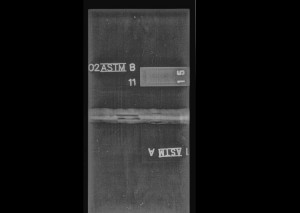 with great clarity and resolution. The software allows for insertion of annotations and an actual digital picture for better overall documentation. Results can be sent to the cloud, put on a thumb-drive, saved to a disc or emailed for others to evaluate. Un-like X-rays which are typically viewed through an intense light source and difficult to replicate.
with great clarity and resolution. The software allows for insertion of annotations and an actual digital picture for better overall documentation. Results can be sent to the cloud, put on a thumb-drive, saved to a disc or emailed for others to evaluate. Un-like X-rays which are typically viewed through an intense light source and difficult to replicate.
Film storage has become obsolete. Electronic images can be archived for efficient storage and retrieval. Digital technology enhances the quality and quantity of records, which allows for rapid and accurate access and quick transmission. The resolution of the image exceeds all other forms of documentation and allows mass quantities to be stored in minimal space, with high resolution a constant. Images are archived on disc or your hard drive, retrievable and transmittable effortlessly to others whether it is next door, in another state or in another country. This allows for multiple inspectors/engineers the efficiency of real-time evaluation of the same radiographic image no matter where they are! In addition to CR, existing film can be digitized to a computerized image. This would reduce storage costs as well as maintain the quality of the image for future evaluation. Adding these technologies to our services allows Applus RTD to continue its promise to not only be on the cutting edge of technology, but also to continue to offer our clients full continuity of service to make their job easier, safer, and cost effective.
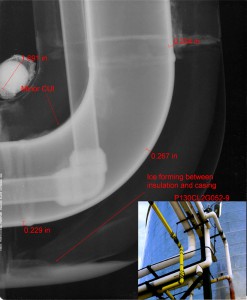 Because of CR, inspections which were once impractical or unachievable can now be successfully completed! In-process piping under insulation in close proximity with personnel, large bore piping, valves and castings can now be inspected safely and cost effectively. The detection of corrosion under-insulation (CUI), while in process or the internal inspection for flow-accelerated corrosion (FAC), using computed radiography has been a proven significant.
Because of CR, inspections which were once impractical or unachievable can now be successfully completed! In-process piping under insulation in close proximity with personnel, large bore piping, valves and castings can now be inspected safely and cost effectively. The detection of corrosion under-insulation (CUI), while in process or the internal inspection for flow-accelerated corrosion (FAC), using computed radiography has been a proven significant.
Speed, cost savings, precision, accuracy, reproduction, ease of archiving and accessibility and most importantly, knowing that your equipment is safe for continued use, all have made CR an invaluable asset to the Industry.
Applus RTD, is committed to using the latest and most effective equipment for our clients testing and documentation.
Applus RTD Applications Specialist – RT reports his thoughts on the future of DCR in NDE as follows: “Within the next few years, I see a rapid decline in the use of conventional film, being replaced with computed radiography. With all of the advantages along with the cost saving potential CR has to offer, it’s just a matter of time.
ASME, AWS, and API have all accepted digital radiography for code acceptance. The military is making strides in doing the same and is currently evaluating its usage in other areas such as corrosion monitoring, composites and new fabrication. The advantages in using digital technology with radiography along with the safety aspects it brings will push its usage within the industry as well as other areas of interest. Currently, the limitation for its use is the user!
